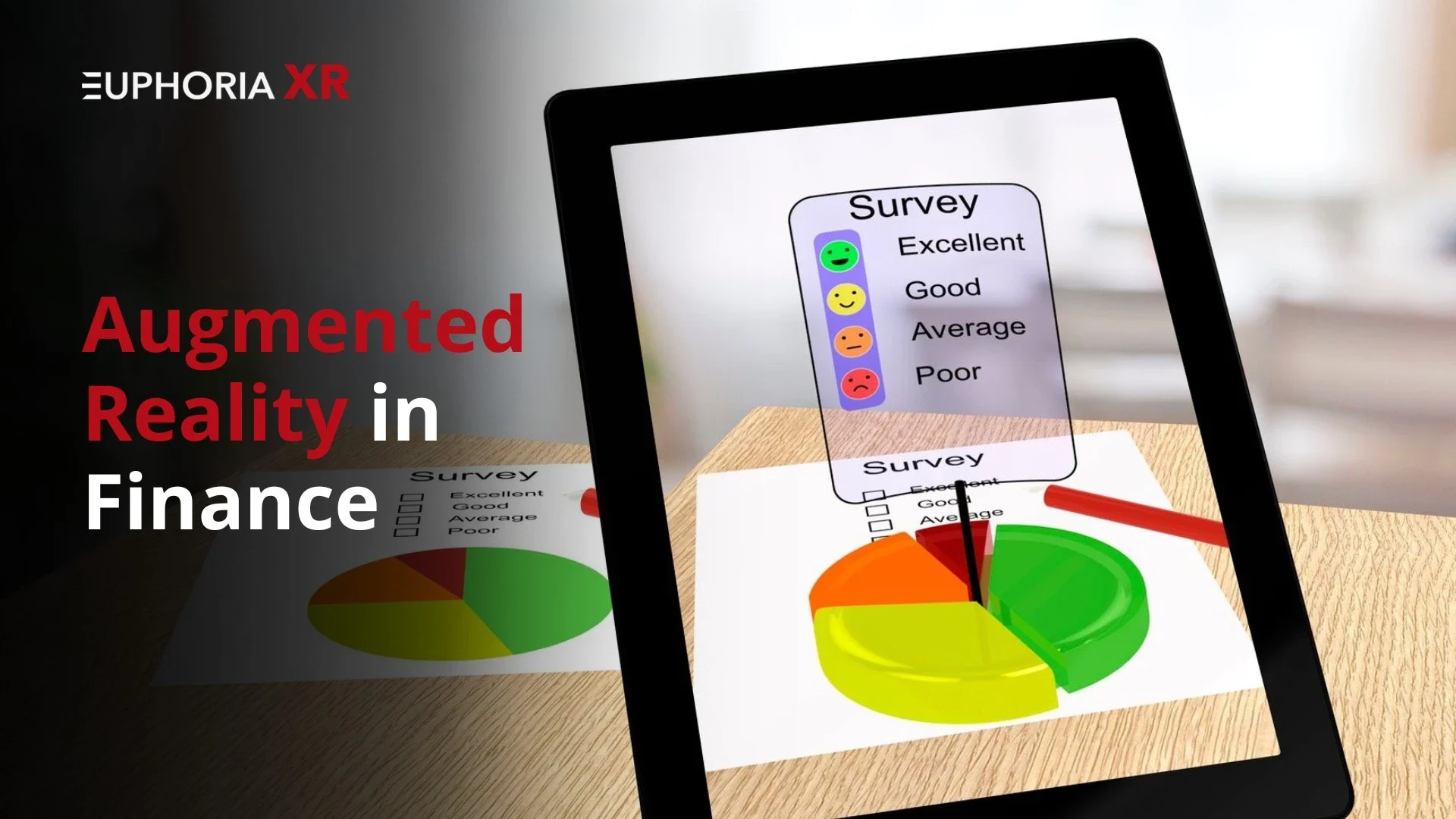Is it Possible to See Financial Management in 3D?
Imagine being able to access financial services, navigate virtual trading floors, and see your investments in real time with only a wave of your hand. The use of augmented reality in finance has arrived and is changing how we deal with money, banking, and investing. It is not a sci-fi fantasy anymore.
AR is revolutionizing financial services, from Augmented Reality Banking to AR Financial Applications that improve user experience and secure transactions. However, what is the precise use of this technology? Let us examine how companies are using augmented reality (AR) in the financial services industry to improve security, efficiency, and engagement.
Use Cases for Augmented Reality in Finance
1. Data Visualization in Financial Services
Enhancing Financial Analysis through Real-Time, Interactive 3D Data Models.
The interpretation of complicated datasets by banking professionals, investors, and financial analysts has been reformed by AR Financial Applications. AR-powered solutions allow customers to engage with real-time financial data in a 3D environment rather than seeing conventional flat charts and reports. Investors can identify patterns that are difficult to spot on traditional dashboards and make data-driven decisions more quickly because of this immersive visualization.
Example: Citi’s Holographic Workstations for Financial Data Insights.
Citi’s Holographic Workstations give financial experts access to a real-time augmented reality interface that allows them to work with 3D financial models to perform in-depth market analysis, overlay risk assessments, and edit stock data.
Advantages:
Makes it possible to interact with financial charts and prediction algorithms in real time.
Provides spatial information to help reduce inaccuracies in market trend analysis.
Helps traders make better investment choices, which improves AR in financial services.
2. AR-Powered Virtual Trading
Immersive trading platforms for real-time market analysis.
Stock traders and investors can now use AR-powered systems to conduct real-time market analysis thanks to the Augmented Reality Banking revolution. Through holographic interfaces or AR overlays on real-world locations, investors can use virtual trading tools to examine price trends, historical data, and current variations.
Example: AR-Powered Stock Trading Dashboards.
Stock trading dashboards with AR capabilities allow traders to follow real-time markets, execute transactions with hand gestures, and engage with data in a captivating manner.
Advantages:
Offers a dynamic trading experience with insights driven by augmented reality.
Enables traders to superimpose past price changes on actual surfaces.
Improves augmented reality investments by enabling traders to see the performance of their portfolios in a realistic setting.
3. Augmented Reality in Improved Insurance Claims
Streamlining claims processing through AR-powered assessments.
AR Financial Applications are being used by insurance companies to expedite the processing of claims, guaranteeing speedier approvals, fraud detection, and damage assessments. Through the use of AR overlays, policyholders can record and submit damage evidence, and insurers can remotely review reports to expedite assessment timelines.
Example: AR-based Damage Assessments in the Insurance Sector.
AR-powered damage assessment systems enable insurers to evaluate houses or vehicles virtually, doing away with the necessity for in-person inspections. This lowers the risk of fraud and expedites claim payments.
Advantages:
Reduces the time needed to process claims by half by using real-time AR verification.
Allows policyholders to submit visual proof augmented by AR for expedited approvals.
Enhances fraud prevention, strengthening AR in financial services.
4. Financial Education, Planning, and Investment with AR
Interactive tools for financial literacy and planning.
With its interactive simulations that let users see investment risks, returns, and financial growth prospects, augmented reality is transforming financial education and investment planning. Through real-time 3D simulations, AR-powered apps assist users in comprehending how inflation, interest rates, and market swings impact investments.
Example: AR Applications that Provide Real-Time Investment Simulations.
AR-based financial literacy applications give users access to real-time investment calculators that let people observe how savings, mortgage rates, and stock values change over time.
Advantages:
Aids users in more efficiently planning and visualizing financial growth.
Enhances consumer interaction with augmented reality banking by offering financial literacy experiences driven by AR.
Provides risk-free augmented reality simulations of possible financial decisions, empowering investors.
Do you need a unique AR app for your company? EuphoriaXR creates scalable augmented reality solutions that improve brand interaction and awareness!
5. Enhanced Customer Service and Communication with AR
AR-driven customer interactions for better engagement.
By providing virtual financial assistants, immersive banking experiences, and improved customer support tools, augmented reality banking is enhancing consumer interactions. Bank employees can use interactive 3D overlays to walk clients through complicated transactions, mortgage applications, or account creation processes with AR-powered remote support.
Example: Bank of America’s AR-based employee training.
Before dealing with actual customers, Bank of America’s AR-based employee training program equips staff with realistic customer service scenarios by simulating real-world banking encounters.
Advantages:
Increases client engagement and happiness through online interactions.
Increases accessibility to banking services using AR-powered remote support.
Provides engaging, instructive banking experiences, enhancing augmented reality in the financial industry.
6. Data Privacy and Security in AR Financial Applications
Strengthening financial security with biometric AR authentication.
Augmented Reality Banking incorporates biometric authentication powered by AR, AI-driven fraud detection, and safe transaction verification in response to growing worries about identity theft, fraud, and cyber threats.
Example: AR-Powered Fraud Detection & Biometric Authentication.
Biometric authentication and AR-based facial recognition technologies safeguard financial transactions, guaranteeing real-time fraud detection and blocking unwanted access.
Advantages:
Uses safe, contactless biometric authentication to reinforce augmented reality in online payments.
Employs security measures driven by augmented reality to cut financial fraud by more than 40%.
Offers a smooth and extremely safe financial experience.
7. AR in Online Payments
Secure and interactive AR payment solutions.
Through the provision of contactless, biometric, and secure transactions, augmented reality is revolutionizing online payments. Consumers can make immediate payments by scanning actual objects or by using authentication enabled by augmented reality.
Example: Contactless AR-Integrated Banking Transactions.
AR-enabled banking apps do not require PINs or the use of physical cards; instead, users can verify transactions using biometric security overlays.
Advantages:
Enhances transaction security through fraud prevention enabled by AR.
Contactless payments powered by augmented reality streamline mobile banking.
Increases consumer confidence in financial applications using augmented reality.
8. Virtual Product Demos for Financial Services
Interactive AR Demos for Banking Products.
Through virtual demos, users can examine banking services, mortgage plans, and investment portfolios with Augmented Reality Banking solutions.
Example: Commonwealth Bank’s Property Search AR App.
The Property Search AR App from Commonwealth Bank helps users make educated decisions by offering real-time property research features and 3D mortgage simulations.
Advantages:
Increases client confidence while making lending and investment decisions.
Offers data-driven, interactive financial product explanations.
Provides immersive experiences that enhance augmented reality in the financial services industry.
9. Simulating Customer Interactions in Virtual Banking
AR-Enhanced Virtual Branch Offices for Remote Banking.
To create virtual branch offices where clients can communicate with bank staff without physically visiting locations, banks are utilizing augmented reality financial applications.
Example: BNP Paribas Real Estate’s Virtual Financial Services.
BNP Paribas Real Estate’s virtual financial services enable clients to access remote banking services and offer virtual financial advising sessions.
Advantages:
Increases clients’ access to banking in far-flung places.
Lowers financial organizations’ operating expenses.
Increases the effectiveness of client care using AR-powered banking.
10. Interactive Portfolio Management with AR
Visualizing Investment Portfolios with AR Technology.
With AR-driven real-time tracking of asset allocations, stock performance, and market changes, investors can now engage with their portfolios.
Example: AR-Driven Asset Management Platforms.
Holographic financial charts enable users to view investment patterns in real time on asset management platforms driven by augmented reality.
Advantages:
Increases the data-drivenness and intuitiveness of portfolio management.
Allows investors to see market patterns in a dynamic augmented reality setting.
Gives real-time portfolio analytics, which improves augmented reality investments.
How Augmented Reality in Banking Bridges the Gap Between Physical and Digital Banking
Financial organizations must preserve individualized customer experiences while guaranteeing safe, effective transactions as banking becomes more digital. By combining virtual financial services, safe AR-powered transactions, and physical banking components with immersive digital solutions, augmented reality in banking is completely changing the industry.
By providing immersive financial planning tools, AR-assisted customer support, and interactive virtual branches, banks may enhance the accessibility, convenience, and security of traditional banking using AR Financial Applications. Augmented Reality (AR) bridges the gap between the real and digital banking experience, from AR-driven biometric verification for increased security to AR-driven investments that offer 3D portfolio visualizations.
🔹 Use AR to Welcome the Future of Banking! Learn how digital payments, customer interactions, and financial services can all be transformed by augmented reality in finance to create a smooth, engaging banking experience.
The Advantages of Augmented Reality in the Financial Services Industry
1. Enhancing the User Experience
Interactive banking solutions are preferred over traditional services by 70% of customers.
By improving the usability and engagement of financial management, augmented reality personalizes banking.
2. Risk Management Enhancement
Banks that use AR-powered fraud detection saw a 40% decrease in cybercrime.
An additional degree of security is provided via real-time biometric authentication.
3. Improves Operational Efficiency
AR improves efficiency by reducing response times for banking services by 50%.
Simplify banking and insurance claim procedures and cut down on paperwork.
4. Customer Engagement and Personalization
65% of millennials choose banks that use digital advances like AR.
Because AR-based services offer personalized experiences, they boost customer engagement.
5. Staying Ahead of the Competition
By 2025, the financial sector’s use of AR is anticipated to increase by 38%.
AR gives financial companies a competitive advantage in online banking.
Case Studies: Real-World AR Applications in Finance
BNP Paribas Real Estate Services – Virtual property exploration through AR.
By incorporating augmented reality (AR) into its real estate services, BNP Paribas has adopted AR in finance and enabled customers to visually tour properties before making investment decisions. Potential buyers can view 3D models of properties, examine financial predictions, and evaluate mortgage costs in real time with the AR-powered platform. By providing an interactive, remote option for investors, particularly those unable to visit physical places, this innovation has revolutionized the conventional property viewing experience.
By using AR, BNP Paribas increases the transparency of decision-making by giving clients access to a virtual picture of the property that overlays predicted rental incomes, estimated maintenance expenses, and neighborhood insights. Customers are now much more engaged and confident, which makes it simpler for people and companies to assess real estate investment opportunities using data-driven insights.
Citi’s Holographic Workstations – 3D visualization of complex financial data.
Through the introduction of Holographic Workstations, Citi has made use of AR Financial Applications to enable traders and financial analysts to view intricate financial data in three dimensions. Traders typically use several screens that are populated with market indicators, stock performance graphs, and financial charts. With the help of gestures, voice commands, or virtual touch controllers, users may alter real-time data projections on Citi’s AR workstations, which replace this clutter with an interactive 3D financial environment.
By providing traders with a more engaging and user-friendly trading experience, this AR-driven strategy improves Augmented Reality Investments by enabling them to monitor market movements, evaluate risk, and more precisely modify portfolio allocations. Traders can make quicker and more informed financial decisions by using spatial analytics to identify minute changes in the market that flat displays could overlook.
Commonwealth Bank’s Property Search AR App – Simplifying home-buying decisions.
With its Property Search AR App, Commonwealth Bank has used augmented reality in banking to help prospective homeowners with their buying process. With the use of this software, users can quickly obtain important financial information, like estimated property worth, previous sale history, mortgage alternatives, and neighborhood statistics, by simply pointing their cell phones at any property.
Customers can compare several houses in real-time with AR overlays, doing away with the necessity for in-person visits and extensive research. Users may modify interest rates, loan terms, and down payments to see how various financial situations impact their monthly installments using the app’s AR-powered mortgage calculator. First-time buyers can now invest in real estate more easily because of this degree of interaction, which also instantly gives seasoned investors significant financial data.
Bank of America’s Employee Training Program – Using AR to improve customer service.
By implementing Augmented Reality Training Modules for its staff, Bank of America has embraced AR in the financial services industry and improved its capacity to provide exceptional customer support. Through the use of augmented reality (AR)-powered simulated banking scenarios, staff members engage with virtual clients and get experience managing a range of customer care scenarios, such as loan applications, credit card disputes, and investment consultations.
By substituting interactive, hands-on experiences for standard classroom instruction, this training approach guarantees that staff members gain a deeper understanding of financial products and improve their ability to interact with customers. The AR-powered system also evaluates employee performance in real-time using AI-driven analytics, giving feedback on areas that require improvement. Bank of America’s dedication to digital transformation in the banking sector has been strengthened as a result of its effective reduction of training time and improvement of client satisfaction ratings.
Implementing AR in Financial Services: Obstacles and Things to Think About
1. Ensuring Data Security and Privacy
The handling of sensitive financial data by AR in financial services raises serious security threats, including data breaches, cyberattacks, and illegal access. To safeguard customer data and transactions, banks must deploy multi-factor security layers, biometric authentication, and end-to-end encryption.
2. Huge Cost of Implementation
It takes a large infrastructure, software, and hardware investment to develop and integrate augmented reality in banking. To cut costs, financial institutions need to investigate cloud-based augmented reality solutions, weigh costs against ROI, and collaborate with fintech firms.
3. Lack of Proper Regulations
The field of augmented reality in finance is developing more quickly than legal frameworks, which raises questions about ethical, security, and compliance issues. Clear government regulations, industry standards, and compliance plans are necessary for banks to guarantee the safe deployment of AR while safeguarding customers.
Despite these obstacles, banks and other financial organizations that use AR wisely will have an advantage in the rapidly changing world of digital finance.
What does AR in finance Look like in the future?
With financial organizations investigating innovative AR solutions to improve customer experience, data security, and digital transactions, the future of augmented reality in banking and financial services is bright.
Future Directions in AR for Finance:
Predictive financial analysis using AI-powered AR — AI and AR are combined to provide real-time stock market forecasts and investment advice.
AR-driven virtual financial advisors: AI-powered AR avatars could be used by banks to offer individualized financial advice using AR-driven virtual financial advisors.
Blockchain and AR integration: Transparent banking through safe financial transactions through blockchain interfaces driven by AR.
Growth in AR-based biometric security: More banks will use AR overlays for transaction approvals and biometric authentication.
AR-driven financial applications will gain traction in wealth management, digital banking, and financial education as a result of investments made by fintech firms and major banks.
How EuphoriaXR Drives Digital Innovation with Its Custom Augmented Reality Development Services
With a focus on custom Augmented Reality solutions, EuphoriaXR is a top Augmented Reality Development Company that provides 3D modeling, virtual tours, web-based AR, mobile AR apps, and customized AR filters to a variety of industries, including gaming, retail, and finance. They produce immersive and interactive augmented reality experiences that improve customer engagement and operational efficiency using innovative tools like Unity, WebXR, and Unreal Engine. EuphoriaXR offers innovative solutions to help organizations stay ahead, whether it is for secure authentication, virtual investing, or banking driven by augmented reality. Find out now how AR can reorganize your sector!
Final Thoughts!
Through improved security measures, streamlined banking procedures, and increased client interaction, the financial industry is transforming thanks to the use of augmented reality. Even though there are still issues with data privacy, regulatory compliance, and implementation costs, AR has the potential to completely transform banking, investing, and financial literacy.
Financial institutions will use AR-powered products to provide a smooth, safe, and engaging digital banking ecosystem with ongoing technical developments, regulatory updates, and strategic deployments.
Frequently Asked Questions (FAQs)?
How is AR used in finance?
Data visualization, customer interaction, online payments, virtual banking, investment research, and fraud protection are all applications of augmented reality in the financial services industry. It streamlines complicated data interpretation and improves financial decision-making in real-time.
What are the benefits of AR in banking?
Enhanced consumer experience through AR-powered product demonstrations and virtual banking support.
Improved security via fraud detection and biometric authentication enabled by AR.
Improved financial planning with real-time data display and interactive investment simulations.
What challenges do financial institutions face with AR?
Hazards to data security, such as illegal access and cyber threats.
High implementation costs for AR-powered banking systems.
Regulations governing AR-based financial services are unclear.
What is the future of AR in finance?
The following are some aspects of augmented reality’s future in banking:
AR apps with AI integration for forecasted financial insights.
AR banking is enabled by blockchain for safe transactions.
Virtual financial advisors and fully immersive augmented reality banking experiences.















